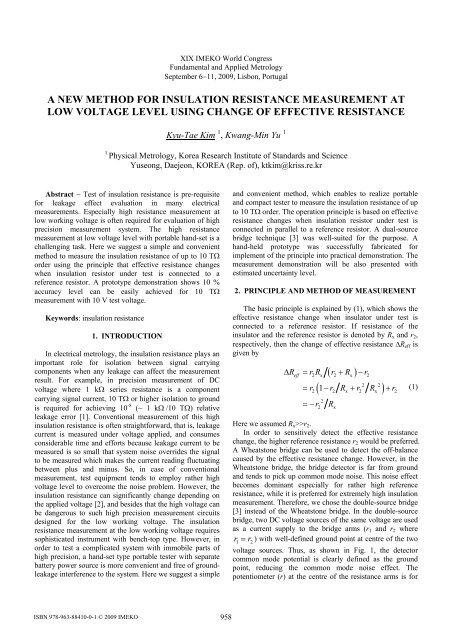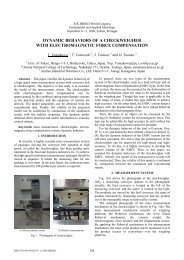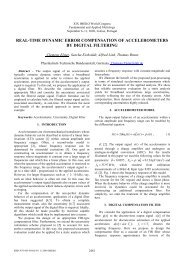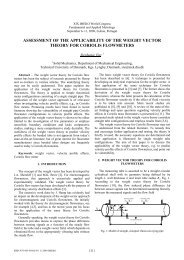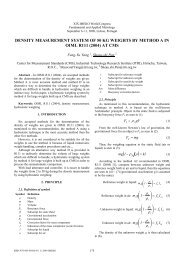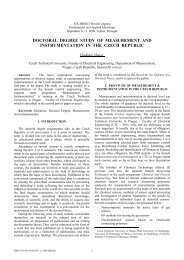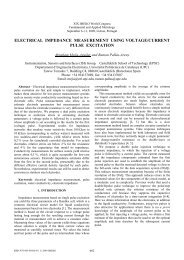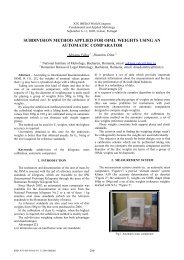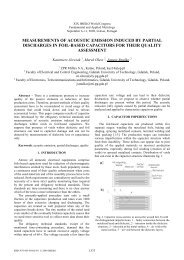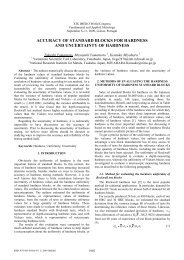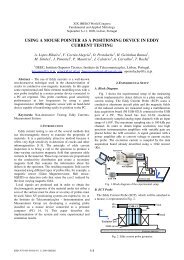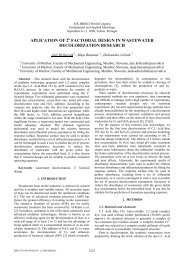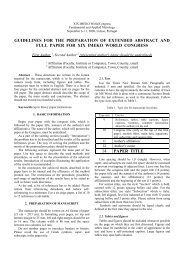a new method for insulation resistance measurement at low voltage
a new method for insulation resistance measurement at low voltage
a new method for insulation resistance measurement at low voltage
Create successful ePaper yourself
Turn your PDF publications into a flip-book with our unique Google optimized e-Paper software.
XIX IMEKO World Congress<br />
Fundamental and Applied Metrology<br />
September 6−11, 2009, Lisbon, Portugal<br />
A NEW METHOD FOR INSULATION RESISTANCE MEASUREMENT AT<br />
LOW VOLTAGE LEVEL USING CHANGE OF EFFECTIVE RESISTANCE<br />
Kyu-Tae Kim 1 , Kwang-Min Yu 1<br />
1<br />
Physical Metrology, Korea Research Institute of Standards and Science<br />
Yuseong, Daejeon, KOREA (Rep. of), ktkim@kriss.re.kr<br />
Abstract − Test of <strong>insul<strong>at</strong>ion</strong> <strong>resistance</strong> is pre-requisite<br />
<strong>for</strong> leakage effect evalu<strong>at</strong>ion in many electrical<br />
<strong>measurement</strong>s. Especially high <strong>resistance</strong> <strong>measurement</strong> <strong>at</strong><br />
<strong>low</strong> working <strong>voltage</strong> is often required <strong>for</strong> evalu<strong>at</strong>ion of high<br />
precision <strong>measurement</strong> system. The high <strong>resistance</strong><br />
<strong>measurement</strong> <strong>at</strong> <strong>low</strong> <strong>voltage</strong> level with portable hand-set is a<br />
challenging task. Here we suggest a simple and convenient<br />
<strong>method</strong> to measure the <strong>insul<strong>at</strong>ion</strong> <strong>resistance</strong> of up to 10 TΩ<br />
order using the principle th<strong>at</strong> effective <strong>resistance</strong> changes<br />
when <strong>insul<strong>at</strong>ion</strong> resistor under test is connected to a<br />
reference resistor. A prototype demonstr<strong>at</strong>ion shows 10 %<br />
accuracy level can be easily achieved <strong>for</strong> 10 TΩ<br />
<strong>measurement</strong> with 10 V test <strong>voltage</strong>.<br />
Keywords: <strong>insul<strong>at</strong>ion</strong> <strong>resistance</strong><br />
1. INTRODUCTION<br />
In electrical metrology, the <strong>insul<strong>at</strong>ion</strong> <strong>resistance</strong> plays an<br />
important role <strong>for</strong> isol<strong>at</strong>ion between signal carrying<br />
components when any leakage can affect the <strong>measurement</strong><br />
result. For example, in precision <strong>measurement</strong> of DC<br />
<strong>voltage</strong> where 1 kΩ series <strong>resistance</strong> is a component<br />
carrying signal current, 10 TΩ or higher isol<strong>at</strong>ion to ground<br />
is required <strong>for</strong> achieving 10 -8 (~ 1 kΩ /10 TΩ) rel<strong>at</strong>ive<br />
leakage error [1]. Conventional <strong>measurement</strong> of this high<br />
<strong>insul<strong>at</strong>ion</strong> <strong>resistance</strong> is often straight<strong>for</strong>ward, th<strong>at</strong> is, leakage<br />
current is measured under <strong>voltage</strong> applied, and consumes<br />
considerable time and ef<strong>for</strong>ts because leakage current to be<br />
measured is so small th<strong>at</strong> system noise overrides the signal<br />
to be measured which makes the current reading fluctu<strong>at</strong>ing<br />
between plus and minus. So, in case of conventional<br />
<strong>measurement</strong>, test equipment tends to employ r<strong>at</strong>her high<br />
<strong>voltage</strong> level to overcome the noise problem. However, the<br />
<strong>insul<strong>at</strong>ion</strong> <strong>resistance</strong> can significantly change depending on<br />
the applied <strong>voltage</strong> [2], and besides th<strong>at</strong> the high <strong>voltage</strong> can<br />
be dangerous to such high precision <strong>measurement</strong> circuits<br />
designed <strong>for</strong> the <strong>low</strong> working <strong>voltage</strong>. The <strong>insul<strong>at</strong>ion</strong><br />
<strong>resistance</strong> <strong>measurement</strong> <strong>at</strong> the <strong>low</strong> working <strong>voltage</strong> requires<br />
sophistic<strong>at</strong>ed instrument with bench-top type. However, in<br />
order to test a complic<strong>at</strong>ed system with immobile parts of<br />
high precision, a hand-set type portable tester with separ<strong>at</strong>e<br />
b<strong>at</strong>tery power source is more convenient and free of groundleakage<br />
interference to the system. Here we suggest a simple<br />
and convenient <strong>method</strong>, which enables to realize portable<br />
and compact tester to measure the <strong>insul<strong>at</strong>ion</strong> <strong>resistance</strong> of up<br />
to 10 TΩ order. The oper<strong>at</strong>ion principle is based on effective<br />
<strong>resistance</strong> changes when <strong>insul<strong>at</strong>ion</strong> resistor under test is<br />
connected in parallel to a reference resistor. A dual-source<br />
bridge technique [3] was well-suited <strong>for</strong> the purpose. A<br />
hand-held prototype was successfully fabric<strong>at</strong>ed <strong>for</strong><br />
implement of the principle into practical demonstr<strong>at</strong>ion. The<br />
<strong>measurement</strong> demonstr<strong>at</strong>ion will be also presented with<br />
estim<strong>at</strong>ed uncertainty level.<br />
2. PRINCIPLE AND METHOD OF MEASUREMENT<br />
The basic principle is explained by (1), which shows the<br />
effective <strong>resistance</strong> change when insul<strong>at</strong>or under test is<br />
connected to a reference resistor. If <strong>resistance</strong> of the<br />
insul<strong>at</strong>or and the reference resistor is denoted by R x and r 2 ,<br />
respectively, then the change of effective <strong>resistance</strong> ∆R eff is<br />
given by<br />
eff<br />
( )<br />
∆ R = r R r + R −r<br />
2 x 2 x 2<br />
2 2<br />
( 1<br />
)<br />
r − r R + r R + r<br />
−<br />
2 2 x 2 x 2<br />
2<br />
r2 Rx<br />
Here we assumed R x >>r 2 .<br />
In order to sensitively detect the effective <strong>resistance</strong><br />
change, the higher reference <strong>resistance</strong> r 2 would be preferred.<br />
A Whe<strong>at</strong>stone bridge can be used to detect the off-balance<br />
caused by the effective <strong>resistance</strong> change. However, in the<br />
Whe<strong>at</strong>stone bridge, the bridge detector is far from ground<br />
and tends to pick up common mode noise. This noise effect<br />
becomes dominant especially <strong>for</strong> r<strong>at</strong>her high reference<br />
<strong>resistance</strong>, while it is preferred <strong>for</strong> extremely high <strong>insul<strong>at</strong>ion</strong><br />
<strong>measurement</strong>. There<strong>for</strong>e, we chose the double-source bridge<br />
[3] instead of the Whe<strong>at</strong>stone bridge. In the double-source<br />
bridge, two DC <strong>voltage</strong> sources of the same <strong>voltage</strong> are used<br />
as a current supply to the bridge arms (r 1 and r 2 where<br />
r1 r2) with well-defined ground point <strong>at</strong> centre of the two<br />
<strong>voltage</strong> sources. Thus, as shown in Fig. 1, the detector<br />
common mode potential is clearly defined as the ground<br />
point, reducing the common mode noise effect. The<br />
potentiometer (r) <strong>at</strong> the centre of the <strong>resistance</strong> arms is <strong>for</strong><br />
(1)
zero adjustment of bridge balance. It is used <strong>for</strong> balance the<br />
bridge be<strong>for</strong>e the <strong>insul<strong>at</strong>ion</strong> <strong>resistance</strong> <strong>measurement</strong> so th<strong>at</strong><br />
the detector reading may become zero without device under<br />
test (DUT) connected.<br />
TΩ. The <strong>measurement</strong> result is shown in Fig. 2. In the <strong>low</strong><br />
range up to 60 GΩ, the inverse law of (2) was s<strong>at</strong>isfactorily<br />
confirmed. A slight devi<strong>at</strong>ion from the inverse law was<br />
found <strong>for</strong> upper <strong>resistance</strong> range. The hypothesis is put<br />
<strong>for</strong>ward th<strong>at</strong> the devi<strong>at</strong>ion is <strong>at</strong>tributable to the nonlinearity<br />
of the detector <strong>at</strong> <strong>low</strong> <strong>voltage</strong>.<br />
Fig. 1. Dual-source bridge <strong>for</strong> <strong>measurement</strong> of <strong>insul<strong>at</strong>ion</strong><br />
<strong>resistance</strong> (R x ). V denotes detector reading.<br />
Fig. 2. Calibr<strong>at</strong>ion of the prototype <strong>insul<strong>at</strong>ion</strong> <strong>resistance</strong> tester.<br />
After the pre-adjustment of bridge balance, DUT (R x ) is<br />
connected to the reference resistor (r 2 ), then the off-balance<br />
reading (V) should be given by<br />
V<br />
U<br />
r<br />
2<br />
(2)<br />
2 Rx<br />
Here we assumed R x >>r 2 . There<strong>for</strong>e the <strong>resistance</strong> to be<br />
measured can be calcul<strong>at</strong>ed by<br />
R<br />
U r<br />
2 V<br />
2<br />
x<br />
(3)<br />
For real applic<strong>at</strong>ion, the rel<strong>at</strong>ion between V and R x can<br />
be calibr<strong>at</strong>ed to provide interpol<strong>at</strong>ion in<strong>for</strong>m<strong>at</strong>ion.<br />
3. PROTYPE AND DEMONSTRAION OF<br />
MEASUREMENT<br />
A hand-held type compact tester was fabric<strong>at</strong>ed <strong>for</strong><br />
demonstr<strong>at</strong>ion of the proposed concept of <strong>measurement</strong>.<br />
Two small 12 V alkaline b<strong>at</strong>teries (A23 type) were used <strong>for</strong><br />
bipolar power source with regul<strong>at</strong>ors of nominal output 10 V.<br />
A variable gain op-amp whose output was directed to a<br />
panel meter (0.1 mV resolution) used as a detector. Two<br />
1 MΩ resistors were used <strong>for</strong> <strong>resistance</strong> arms so th<strong>at</strong> the<br />
theoretical maximum range corresponds to 10 TΩ.<br />
A set of reference resistors in the range of 2 GΩ to 10<br />
TΩ was measured with the fabric<strong>at</strong>ed hand-held type<br />
compact tester. The reference resistors were megohm<br />
decade (Biddle megadek) <strong>for</strong> the range be<strong>low</strong> 100 GΩ, and<br />
fixed standard resistors (Guildline 65206) of 1 TΩ and 10<br />
4. CONCLUSIONS<br />
The proposed concept of <strong>new</strong> <strong>measurement</strong> <strong>method</strong><br />
using double-source bridge was demonstr<strong>at</strong>ed by a prototype<br />
hand-held tester fabric<strong>at</strong>ed with compact portable case. The<br />
calibr<strong>at</strong>ion d<strong>at</strong>a was experimentally obtained <strong>for</strong> the<br />
prototype. Although there is a slight devi<strong>at</strong>ion from the<br />
inverse law <strong>at</strong> extremely high <strong>resistance</strong> range, it is valid<br />
th<strong>at</strong> a calibr<strong>at</strong>ion will provide a possible way <strong>for</strong><br />
interpol<strong>at</strong>ions up to 10 TΩ. The overall uncertainty of<br />
<strong>measurement</strong> with the interpol<strong>at</strong>ion is estim<strong>at</strong>ed to be less<br />
than 10 %.<br />
ACKNOWLEDGMENTS<br />
Authors would note th<strong>at</strong> the work was supported by<br />
KRISS internal R&D budget.<br />
REFERENCES<br />
[1] S Solve, R Chayramy, M Stock, K-T Kim, W Song, M-S<br />
Kim and Y Chong, “Bil<strong>at</strong>eral comparison of 1.018 V and 10<br />
V standards between the KRISS (Republic of Korea) and the<br />
BIPM, February 2008 (part of the ongoing BIPM key<br />
comparison BIPM.EM-K11.a and b)”, Metrologia vol. 45<br />
01007, 2008.<br />
[2] B. N. Ellis, “Low Voltage Insul<strong>at</strong>ion Resistance<br />
Measurement of Printed Circuits and its Implic<strong>at</strong>ions”,<br />
Circuit World, vol. 14, nº. 2, pp. 21-25, 1988.<br />
[3] D. G. Jarrett, “Autom<strong>at</strong>ed guarded bridge <strong>for</strong> calibr<strong>at</strong>ion of<br />
multimegohm standardresistors from 10 MΩ to 1 TΩ”, IEEE<br />
Trans. Instrum. Meas., vol. IM-46, nº. 2, pp. 325-328, 1997.


